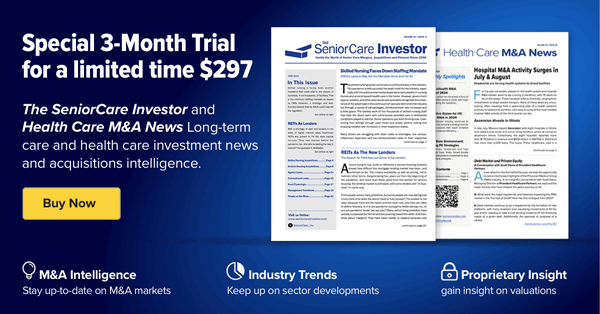According to data captured from the LevinPro HC database, 2022 was a historic year for healthcare M&A, with a record-breaking 2,392 transactions announced, and we expect this number to continue to climb as companies report their final deals of the year. The Home Health & Hospice (HH&H) M&A market, however, experienced an approximately 29% decline in transactions, dropping from 155 announced in 2021 to 110 announced in 2022. The home health market was hindered by industry headwinds in 2022, including staffing shortages and Medicare rate cuts.
Despite the decline in M&A during 2022, when we spoke with industry experts Al Veach and Jason Harrison of Agenda Health last month, they were optimistic about the market rebounding in the new year, fueled by multibillion-dollar transactions from large private equity firms and retailers seeking to expand their home health services. We forecast a strong outlook for HH&H M&A deals in 2023 with companies actively exploring M&A, divestitures and other transactions.
Last year was the year of large, disruptive deals in the HH&H market, and we expect that trend to continue on into 2023. During 2022, companies like CVS Health (NYSE: CVS) and UnitedHealth Group’s (NYSE: UNH) Optum shelled out billions of dollars into the industry with large acquisitions. In fact, CVS Health’s $8 billion acquisition of Signify Health (NYSE: SGFY) in September 2022 was the sixth largest transaction of the year across all sectors, and the largest HH&H deal announced. When large Fortune 500 companies like CVS Health are investing heavily in their home health plans, it proves the ethos of home-based care. CVS Health was making some moves prior to the deal, but as it builds out its health care services, it needed a company that drove value and had more capabilities in the home, which is where Signify Health comes in.
The Dallas-based Signify Health is a value-based, tech-enabled care provider that leverages at-home health risk assessments. The company has more than 10,000 clinicians under its nationwide umbrella.
“This acquisition will enhance our connection to consumers in the home and enables providers to better address patient needs as we execute our vision to redefine the health care experience,” CVS Health CEO Karen Lynch said in a statement after the acquisition was announced. “In addition, this combination will strengthen our ability to expand and develop new product offerings in a multi-[payer] approach.”
UnitedHealth Group’s Optum rivals Signify when it comes to at-home risk assessments. UnitedHealth Group is positioning Optum as a cornerstone of its growing home-based care infrastructure and expansion of value-based service delivery. The company has already deployed billions in capital to fortify Optum’s home health services through large, high-profile acquisitions. In March 2022, Optum announced its agreement to purchase LHC Group (NASDAQ: LHCG), a Lafayette, Louisiana-based home health and hospice provider, for $5.5 billion. Optum’s acquisition of LHC Group is expected to finalize during the first quarter of the year, kicking off 2023 with a bang.
“[A] tenant of our consumer focus is meeting people where they are, which includes expanding our clinical capabilities to care for people more holistically in their homes,” UnitedHealth Group CEO Andrew Witty said during a third-quarter earnings call. UnitedHealth Group plans to further develop and scale their medical, behavioral, home health and palliative care capabilities. By doing this, UnitedHealth Group hopes to slash its healthcare spending by helping patients stay in a lower-cost home setting and prevent avoidable high-acuity admissions.
Optum’s third-quarter revenues rose 17% to $46.6 billion year-over-year, driven by growth in value-based care arrangements and continued expansion of care delivery platforms, including at-home care. According to Witty, further expansion through a diversified range of acquisitions is likely, but whether that’s specifically in the HH&H market remains to be seen. “In terms of our ramp-up of capital deployment, we have very substantial continued capacity. And obviously, the marketplace is getting interested in and around that space,” Witty said. “The pipeline of opportunities is probably as diverse as we’ve ever seen across a number of key growth platforms.”
Optum is not the only managed care services provider showing interest in home health care. In April 2021, Humana (NYSE: HUM), a Fortune 500-ranked American health insurance company based in Louisville, Kentucky, acquired Kindred at Home, the largest home health and hospice provider in the United States. With the acquisition, Humana solidified its position in the HH&H market, becoming the nation’s largest provider of care in the home. In June of that year, the health insurance company followed up with the acquisition of onehome, which provides post-acute and home-based care to patients who were recently discharged from emergency rooms and hospitals.
During a Q3:22 earnings call, Humana CFO Susan Diamond laid out plans to add patients to its value-based home health business going forward. Humana has an advantage over other home health companies, having both a home health arm and a Medicare Advantage (MA) plan under its umbrella.
“The team is working on implementing a full value-based model, which is inclusive of utilization management, network management and clinical advancement to take full capitated risk on Medicare patients,” Diamond said. “We expect to have 15% of our members covered by that model by the end of the year.” That 15% represents an additional 450,000 MA members being covered by the value-based home health model, according to the company. Humana will be offering value-based home health to its own MA members initially, and then will look to offer similar value-based structure to other MA plans outside its network moving forward.
Telehealth will continue to shape the care industry in 2023. In November, the Centers for Medicare and Medicaid Services (CMS) released its final 2023 Medicare Physician Fee Schedule (PFS) rule.
During the height of the COVID-19 pandemic, CMS temporarily offered 151 new Medicare services using telehealth. CMS even created an entirely new tier called category 3 for this purpose. As COVID-19 case numbers began to dip in 2022 (though who’s to say when we’re finally in the clear), many in the HH&H industry began to fear Medicare/Medicaid reimbursement for telehealth services would be dropped.
In November, CMS brought good news to at-home telehealth users. Following the home health final rule of 2023, CMS has created 59 additional services to Category 3 and full coverage to the end of 2023. Notably, the Consolidated Appropriations Act of 2022 requires that CMS still offer telehealth services to patients who cannot leave their homes in rural areas or need audio-only options available. In 2021 and 2022, we saw the home health industry change drastically due to telehealth expansion allowing more people to receive their healthcare at home.
Technology implementation has the potential to greatly change the industry in 2023 and beyond. One new trend just starting to bubble up is the use of Virtual Reality (VR) in providing home health, hospice and palliative care. MyndVR is one such company, which makes its VR technology available to individual adults aging in their own home. While MyndVR’s products and services are available directly to consumers, the company also has formed partnerships with home-based care agencies, skilled nursing operators and veteran homes to bring VR healthcare to those communities.
In Late 2022, MyndVR partnered with the computer manufacturing company HTC Corp. (TPE: 2498) to co-launch a set of immersive glasses seniors can use from their homes. The HTC Vive Flow weighs a third of the weight of traditional VR headsets, which can sometimes be hard for seniors to use, making it a great option for use at home. The HTC Vive Flow is just the start, as more companies will look to enter the Metaverse and expand their care footprint with the ‘digital pill’. 2023 and the years that follow will bring with them a whole new generation of therapeutic tools to provide care to people of all ages in their homes.
2023 will be an exciting year for the home health industry. So far, the HH&H market, which took off during COVID-19 out of necessity, has managed to stay above water with new innovations in technology and large companies continuing to show interest. Whatever 2023 brings to the HH&H market, we will be covering it on the LevinPro HC platform.


